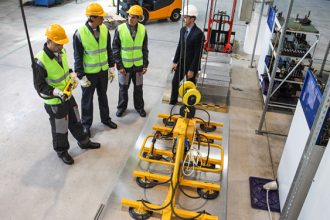Three Ways Overhead Lifting Solutions Prevent Product Damage

Crash. Smash. Boom.
Those aren’t just the sounds of products being damaged as they’re moved around a distribution center or manufacturing facility by a traditional, floor-based vehicle, such as a forklift. Those are also the negative impacts made on the bottom line, thanks to product damage. Those costs include:
- The loss of the product itself.
- The expenses associated with repairing or scrapping it.
- The time lost in storing or manufacturing it.
- The dissatisfaction of the customer who anticipated receiving an intact product in a certain timeframe—or who receives a damaged product—and the potential loss of that customer.
- The potential damage to the facility or other equipment used within it if the product is damaged by an impact with another structure or piece of machinery.
Overhead lifting solutions, such as cranes, hoists and monorails, offer an alternative to floor-based product movement that greatly minimizes the risk of damage—and the corresponding negative impact on the bottom line. They do this in three ways:
1. Obstacle Avoidance. Overhead handling equipment allows for direct-path transportation over the top of any obstacles that may impede the straight-line path of a floor-based load transport vehicle as it maneuvers through narrow spaces and around tight corners. Products literally sail through the air, avoiding potential impacts and subsequent damage by virtue of being lifted and moved overhead.
2. Controlled Movement. Overhead lifting systems automatically self-center each load, significantly minimizing the chance of the product overturning or making contact with walls, structural supports or other machinery and equipment. Further, these solutions’ controllers are equipped with soft-start features that gently initiate product lifting and movement, as well as multiple or variable speed options for optimized control as the load is maneuvered to its destination.
3. Load-Specific Attachments. In addition to the monorails, cranes and hoists themselves being customized to each unique application, there are a variety of load-specific below the hook devices (also sometimes called end effectors) that can be utilized to optimize the handling of different types of products. These include C hooks, gripping lifters, mechanical lifters, vacuum lifters, sheet lifters, lifting beams, magnets, slings and drum turners, among other styles.
Looking for more information on how overhead lifting solutions can make a positive impact on the bottom line? Find another 12 ways these technologies improve manufacturing and distribution productivity, safety and throughput in “Expand Your Possibilities. Discover the Potential. Choose Overhead Lifting.” The free publication is made available by MHI’s Overhead Alliance, which includes the Crane Manufacturers Association of America (CMAA), the Hoist Manufacturers Institute (HMI), and the Monorail Manufacturers Association (MMA).



